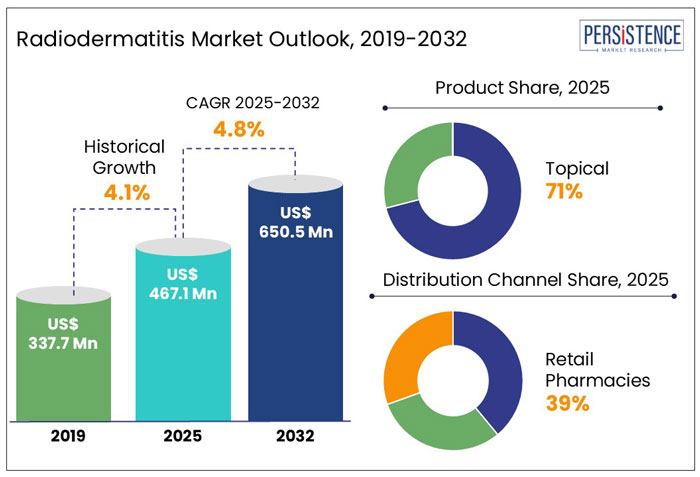Industry: Healthcare
Published Date: March-2025
Format: PPT*, PDF, EXCEL
Delivery Timelines: Contact Sales
Number of Pages: 250
Report ID: PMRREP35159
The global radiodermatitis market size is anticipated to rise from US$ 461.7 Mn in 2025 to US$ 650.5 Mn by 2032. It is projected to witness a CAGR of 4.8% from 2025 to 2032.
The radiodermatitis market is witnessing notable growth, propelled by advancements in wound care technologies and a rising number of patients undergoing radiation therapy.
Companies investing in innovative solutions like smart dressings with real-time monitoring and stem-cell-based skin regeneration therapies have substantial opportunities to set new industry standards.
As hospitals and cancer centers seek more effective and durable treatments, businesses focusing on cutting-edge radiodermatitis solutions can gain a competitive edge in this expanding market.
The radiodermatitis market presents promising growth prospects, particularly in the topical product segment. Market players who leverage advanced wound care technologies and address the evolving needs of healthcare providers are well-positioned to capitalize on these opportunities.

Key Highlights of the Radiodermatitis Market
|
Global Market Attributes |
Key Insights |
|
Radiodermatitis Market Size (2025E) |
US$ 467.1 Mn |
|
Market Value Forecast (2032F) |
US$ 650.5 Mn |
|
Projected Growth (CAGR 2025 to 2032) |
4.8% |
|
Historical Market Growth (CAGR 2019 to 2024) |
4.1% |
Increasing Number of Cancer Patients Augmented Market Growth
During the historical period from 2019 to 2024, the radiodermatitis market has experienced steady growth in recent years, driven by an increasing number of cancer patients undergoing radiation therapy.
The focus was primarily on symptom management, with limited innovation in advanced wound care technologies. Growth was driven by rising cancer cases, greater awareness among healthcare professionals, and improvements in hospital infrastructure, particularly in Asia-Pacific and North America.
Shift Towards High-Tech Wound Care Solutions to Boosts Market Demand
Over the forecast period, the industry is shifting towards high-tech wound care solutions, including nanotechnology-based creams, hydrogel dressings, and smart dressings with real-time monitoring.
Increased investment in stem-cell-based skin regeneration and biologics is expected to redefine treatment protocols. The e-commerce and telemedicine boom also transforms distribution channels, making advanced treatments more accessible.
Rising Cancer Cases and Increased Radiation Therapy
Every year, millions of cancer patients undergo radiation therapy as part of their treatment plan. While this life-saving procedure helps shrink tumours and destroy cancer cells, it often comes with an unavoidable side effect of radiodermatitis.
Imagine a patient undergoing weeks of radiation, only to develop painful skin reactions like redness, peeling, and irritation. The growing global burden of cancer means that more patients are experiencing these complications, fuelling the demand for effective radiodermatitis treatments.
As oncology care advances, healthcare providers are actively seeking topical creams, dressings, and oral medications that can help manage symptoms and improve patient's quality of life. This increasing need is driving significant growth in the radiodermatitis market, pushing companies to develop innovative solutions to ease patients' discomfort.
Limited Awareness and Delayed Diagnosis Impedes Market Growth Trajectory
Imagine a cancer patient undergoing weeks of radiation therapy, unaware that their persistent skin irritation is actually radiodermatitis.
Many patients and even some healthcare providers mistake early symptoms, such as mild redness and itching, as temporary side effects rather than a condition requiring medical intervention. This lack of awareness leads to delayed diagnosis and treatment, often resulting in more severe complications like skin ulceration and infections.
In low-resource settings, access to dermatology specialists and proper wound care products is limited, further delaying effective management. Without widespread education campaigns and early intervention protocols, the radiodermatitis market faces growth restraints.
Innovation in Advanced Wound Care Technologies Presents Key Opportunities to Market Players
The emergence of hydrogel dressings, biological skin substitutes, and nanotechnology-based creams is transforming how radiodermatitis treatment is approached.
Such innovations not only provide faster healing and better hydration but also help reduce inflammation and discomfort. Companies investing in smart dressings with real-time monitoring or stem-cell-based skin regeneration therapies have a tremendous opportunity to set new industry standards.
As hospitals and cancer centers seek more effective and long-lasting treatments, businesses focusing on cutting-edge radiodermatitis solutions can gain a competitive edge in this growing market.
Topical Segment to Dominate Product Segment with 71% of the Market Share
The topical product segment accumulated the predominant market share, accounting for around 71%. An important factor in the growth of topical products is their various benefits, including ease of use, availability, and affordability.
Topical preparations reduce the likelihood of microbial transmission while offering a protective barrier against abrasive agents. This section comprises corticosteroids, hydrophilic creams, antibiotics, and other substances.
In September 2024, an article in Applied Sciences examined a study investigating the incorporation of plant-derived compounds from the Boswellia species in topical formulations for post-radiotherapy skin care.
The study sought to mitigate skin damage induced by free radicals during therapy by the integration of antioxidant-laden plant extracts.
Diverse cosmetic formulations were created, and their stability, characteristics, and antioxidant efficacy were assessed in conjunction with sensory evaluation to determine their effectiveness.
Retail Pharmacies to Own the Largest Market Share of 39% Owing to its Extensive Availability & Ease of Access
Retail pharmacies constituted the largest portion of the distribution channel segment, representing 39%. The substantial proportion can be attributed to their extensive availability, facilitating patients' access to essential treatments.
Retail channels offer a variety of products specifically designed for skin problems, including radiodermatitis, thereby augmenting consumer options.
Retail pharmacies have cultivated partnerships with healthcare providers, enabling patient referrals and recommendations. The ease of acquiring drugs without a prescription further stimulates sales through these channels, augmenting market's growth.

Europe Radiodermatitis Market Dominates the Global Market with 34% of the Total Market Share
The radiodermatitis market in Europe is driven by an increasing population of cancer patients receiving radiation therapy. The regulatory endorsement for novel dermatological products and therapy in the region further augments business prospects.
Enhancing public health activities to inform patients about skin care during cancer treatment substantially stimulates the market for radiodermatitis products in several European nations.
The UK radiodermatitis market is anticipated to grow due to the growing incidence of cancer patients necessitating radiation therapy, resulting in an increased prevalence of skin-related adverse effects.
Innovations in treatment methods and the increasing awareness of skin care management among healthcare practitioners assist market expansion.
North America Radiodermatitis Market to Own Substantial Market Share With High R&D Investments
The North America radiodermatitis market is expected to experience substantial growth during the forecast period. The market is primarily propelled by substantial R&D investments by multinational entities and their emphasis on securing a competitive advantage.
Growing disposable income and the existence of advanced healthcare facilities contribute to substantial growth prospects throughout the region.
U.S. Radiodermatitis Market
The U.S. radiodermatitis market commanded the highest share in North American region and is projected to experience rapid growth throughout the forecast period. Progress in treatment methods and increased awareness of skin care during radiation therapy drive the market's expansion.
In April 2024, a study published in the Journal of Radiation in Practice investigated the application of KeraStat Cream (KC) for radiation dermatitis in patients with head and neck cancer receiving irradiation.
The pilot trial included 24 patients and demonstrated that treatment adherence was comparable between KC and conventional care, with no significant changes in radiation dermatitis noted.
Asia Pacific Radiodermatitis Market to Witness Fastest Growth
The Asia Pacific radiodermatitis market is expected to experience the highest growth rate during the forecast period. Region's increasing population of cancer patients is a primary contributor to its substantial market share.
The significant market share attained by this region is attributable to extensive partnerships established by prominent companies to expand their product offerings. Primary growth catalysts for this region encompass advantageous governmental initiatives that enhance research endeavors and increased outsourcing by developed economies.
The radiodermatitis market is highly competitive, with key players focusing on innovation, partnerships, and new product launches to strengthen their market presence.
Companies in the industry are investing in advanced skincare solutions and radiation therapy management products. Rising demand for topical treatments, biologic dressings, and oral medications has intensified competition.
Emerging players are leveraging natural and organic formulations to meet patient preferences. Strategic collaborations with hospitals and oncology centers are driving market expansion.
As radiation therapy cases rise globally, the need for effective radiodermatitis treatments continues to grow, making research and development a key differentiator. The evolving landscape offers ample opportunities for established brands and new entrants in the radiodermatitis treatment market.
Key Industry Developments
|
Report Attributes |
Details |
|
Historical Data/Actuals |
2019 - 2024 |
|
Forecast Period |
2025 - 2032 |
|
Market Analysis Units |
Value: US$ Bn/Mn, Volume: As applicable |
|
Geographical Coverage |
|
|
Segmental Coverage |
|
|
Competitive Analysis |
|
|
Report Highlights |
|
|
Customization and Pricing |
Available upon request |
By Product
By Distribution Channel
By Region
To know more about delivery timeline for this report Contact Sales

The market is set to reach US$ 467.1 million in 2025.
Stratpharma AG, Smith & Nephew, Molnlycke Health Care AB, are a few leading players.
The industry is estimated to rise at a CAGR of 4.8% through 2032.
Europe is projected to hold the largest share of the industry in 2025.
The market is anticipated to reach a valuation of US$ 650.5 million by 2032.